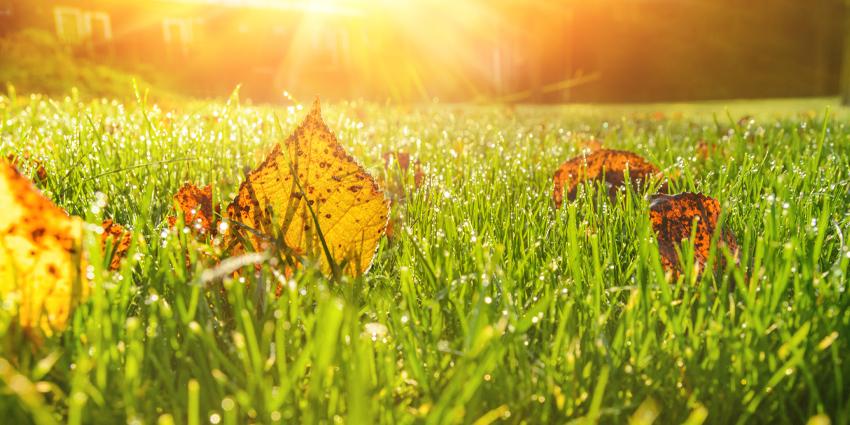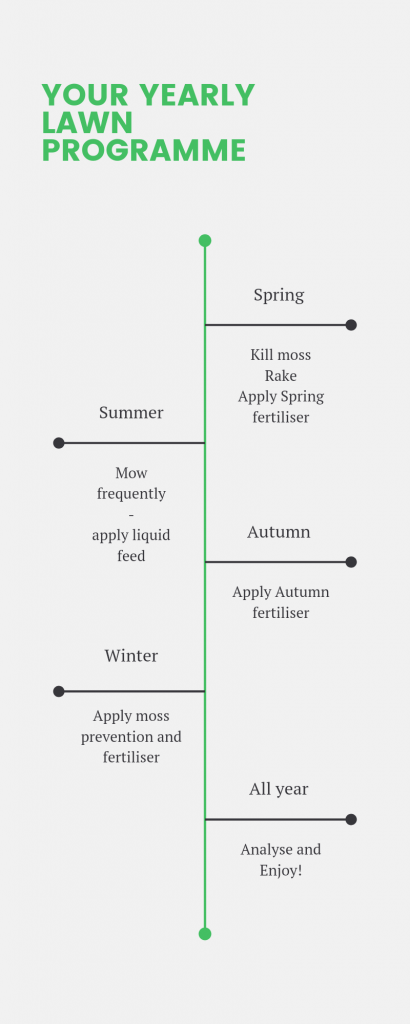
Created By
Matt Adams
Updated On
- February 29, 2024
Get FREE Exclusive Access
Keep your lawn pristine with exclusive tips, offers and insights that I only share with my private subscribers.
Latest Posts
How do I take care of my lawn year round?
- By Matt Adams
- February 29, 2024
Jump to
Get FREE Exclusive Access
Keep your lawn pristine with exclusive tips, offers and insights that I only share with my private subscribers.
Today I’ll share my knowledge on how to look after your lawn throughout the year. First I’ll just touch on some important points. Then we’ll go through the seasons and which jobs, fertilisers and feeds are best for which month of year.
Cos that’s the best way to look at the monthly lawn calendar – based on the time of year
A key thing to remember is that a bit of TLC in the Autumn and Winter will give you a higher chance of having your grass pitch perfect ready for the following Spring.
That’s because the grass will have time to absorb the feed over the harsh Winter months, while keeping its roots strong and its blades green.
For the purpose of this guide, let’s start with the first task of the calendar year.

Our full year lawn fertiliser kits make your year super simple
How to take care of the lawn in Winter

Planning your Year in January and February
You hopefully removed any fallen leaves so the grass can breathe. A bit of aerating wouldn’t go amiss either if you’ve got the guts to get out in the cool fresh air in Jan and Feb.
February is the perfect month for planning your lawn calendar. So, all you need to do is get your spreadsheet out and draft out what you’re going to do to keep your lawn nice and healthy. That’s where this article comes in – WAM BAM THANK YOU MAM!
If you have high microbial activity, then you may experience worm casts and want to squish them – read my article on worm casts first though
How to take care of the lawn in Spring

Diminish Moss in March
We’re essentially now in Spring – Buzzin! So, March is the time to start getting rid of Moss on your lawn. If you’re lawn is under big trees or on dense ground, then it’s highly likely to be competing with the intruding monster that MOSS is.
First of all, get yourself some proper Moss killer. Try to avoid anything that says it is Fertiliser AND Moss killer – they just aren’t as good. Especially if you have a large moss problem.
A liquid soluble moss killer is a great choice and you will find the amount needed per square meter is approximately 4g. Each 4g will be mixed with 1 litre of water.
So put simply – if you have a 6 litre watering can ‘they’re very popular’ you’ll need 24g of Moss Killer, a full watering can and you can sprinkle the whole lot over 6 metres squared of your lawn.
Repeat this step until you’ve covered the whole lawn. NEVER go over the recommended amount – Why? You’ll scorch the lawn. Not Good!
Spring into Action in April
Now it’s time to pick up the mower if you haven’t alread,y as well as running the scarifier over the lawn. You want to make sure the grass is growing fully before scarifying though, otherwise you may do more damage than good.
If you feel you need to offer a bit more TLC, now is the time to overseed any bare patches.
Careful here though because if you do overseed, you will limit your options for using weed and feed later in the year. NEVER use weed and feed on newly sown grass seed.
Hopefully you had your mower blades sharpened in Feb or you have bought a new blade. If not, be sure to do this before mowing the lawn.
Take your time when scarifying – try not to speed scarify – here’s why.
You are currently viewing a placeholder content from Default. To access the actual content, click the button below. Please note that doing so will share data with third-party providers.
More InformationA bit more mowing in May
Mowing is going to be the star of the tasks in May. But there’s much more to styling than simply giving it a trim.
About 6-8 weeks after killing the moss and scarifying the dead undergrowth, you can begin your next feed of the fresh cut grass. That will most likely be in May – when the skies are blue and the rains are (fairly) sparse (except in Manchester of course).
Be sure to remove any weeds by hand especially the big ones and it’s usually best to do this by hand because it’s more eco friendly and you can be much more precise.
If you have clover starting to spread, then you may want to use a spot treatment to remove them too.
If you overseeded in April, then you definitely don’t want to use a weed and feed, but a starter fertiliser instead.
How to take care of the lawn in Summer

The Joy of the Lawn Juice in June
Now we’re coming into the height of the Summer and you defo want to start enjoying your garden by taking a beer or a gin cocktail and chillin’ in your beer chair.
Not for long though – I bet you won’t be able to stop yourself from getting up and giving your lawn the once over.
So, liquid feed is a must in the height of the summer. Using liquid means the nutrients will be absorbed by the soil even if the weather is super warm. So, you won’t need to worry about scorching the lawn.
Sit Back & Enjoy July
Hey Ho! Now we’re getting hot and humid in the UK as well as seeing the possibility of a hose pipe ban. The goal here is to keep the grass moist. This will be more important if you lawn is right next to a huge Conifer. That’s because they are the beasts taking ALL the water.
Some lawns might be susceptible to chafer grubs or leather jackets. If yours is, then take the time to apply a bug protector/killer
Other than that, simply enjoy the fruits of your labour during late Spring and early Summer.
Again & Again in August
Keep mowing frequently in August and remember to ask a friend to help if you’re going away for longer than a couple of weeks. You might need them to water the plants too.
It’s now a good time to apply a liquid feed to the lawn. Use a high quality feed so the grass can absorb the nutrients fully.
I’d also highly recommend avoiding a granular feed during the height of the Summer. The dry weather means it may not absorb into the soil very well and therefore could scorch the grass.
Carry on making sure the lawn stays moist. Especially during the hotter days of that August might bring.
Note too, you could also apply a ph soil modifier such as lime in Autumn. Dong it now will give it chance to settle into the soil bed as we go through to the following Spring.
How to take care of the lawn in Autumn

Slightly Wetter is Better in September & October
As the months begin to get cooler and no doubt slightly wetter, it’s time to start thinking about the Autumn lawn care.
Depending on when you applied the last fertiliser will determine when you lay your Autumn feed, For example if you applied it late Summer, then it’s best to wait until October before applying the next one.
Mowing will reduce – hooray! Keep the blades fairly high too – remember the roots grow as long as the blades are tall and you ned long healthy roots to get through Winter.
Finally, if necessary, now is a good time to sow your repair seeds.
Why?
Because the soil is warm (above 8 degrees) and the ground stays moist. There’s also a much lower risk of frost during September and October.
If you are sowing seeds, it’s a good idea to also apply top dressing. That way the growth will be stimulated and more likely to mature before the cold Winter months set in.
No More Leaves in November
If you’re like me, you despise leaves falling on your lawn. And we have massive trees, which cause me lots of headache. Try to remove the leaves asap as they begin to fall on the lawn.
That way you will make sure the grass can breathe and stay strong.
You can continue to mow the lawn if it still looks like it’s growing, but expect the growth to be much much slower by now.
It’s Winter again
Not Yet Done in December & January
Who said there was nothing to do in December? Well, it’s now time for the boring jobs – clean, clean, clean
If you want your equipment to stand the test of time, then it’s a great idea to clean the mower and it’s components before putting it away for good.
December or January is a good time to apply a winter fertiliser. One that’s designed to help the grass stay healthy in harsh weather.
Other than that, get yourself ready for Christmas and look forward to starting the season again in Feb.

This Post Has 3 Comments
This is so so helpful. Thank you so much!
Pingback: Preparing the ground & soil for turf - Lawn Feed & Fertiliser
Pingback: How to get rid of moss in your lawn | Best Moss Killer Removal Treatment